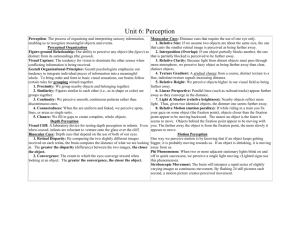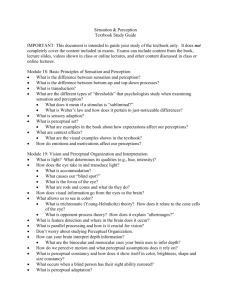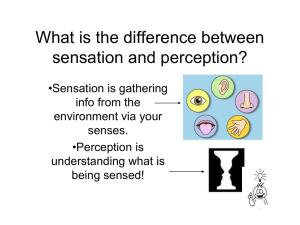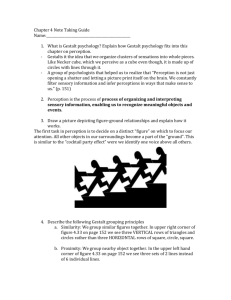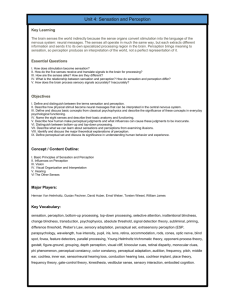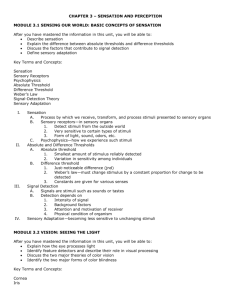Lesson Plan 2-21 Perception
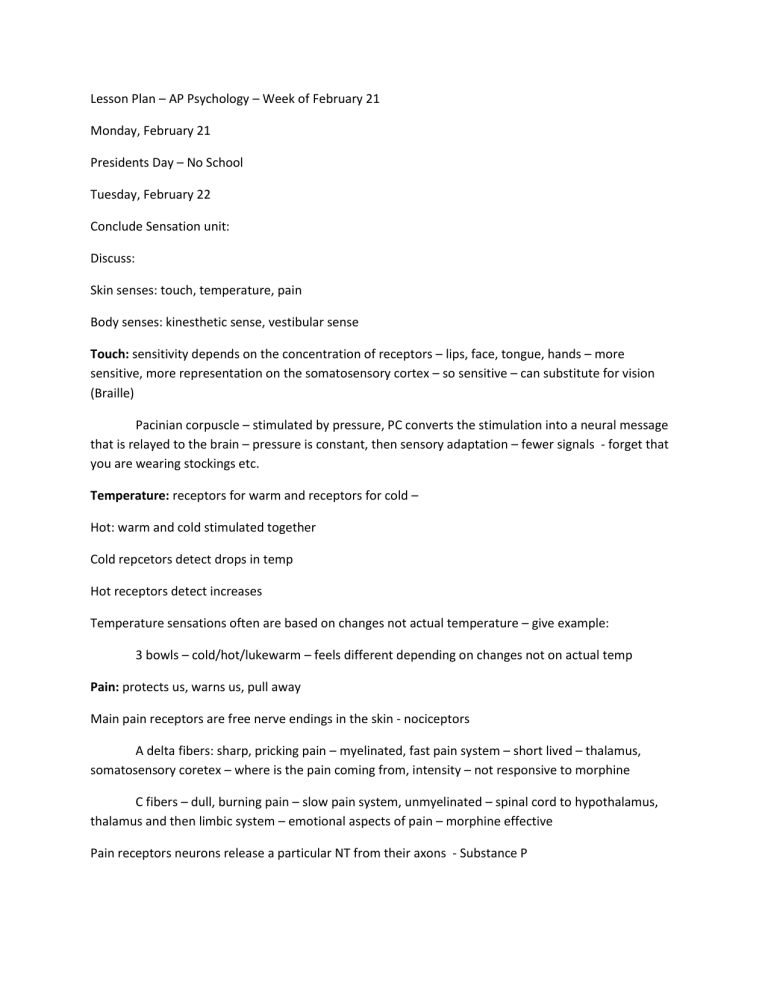
Lesson Plan – AP Psychology – Week of February 21
Monday, February 21
Presidents Day – No School
Tuesday, February 22
Conclude Sensation unit:
Discuss:
Skin senses: touch, temperature, pain
Body senses: kinesthetic sense, vestibular sense
Touch: sensitivity depends on the concentration of receptors – lips, face, tongue, hands – more sensitive, more representation on the somatosensory cortex – so sensitive – can substitute for vision
(Braille)
Pacinian corpuscle – stimulated by pressure, PC converts the stimulation into a neural message that is relayed to the brain – pressure is constant, then sensory adaptation – fewer signals - forget that you are wearing stockings etc.
Temperature: receptors for warm and receptors for cold –
Hot: warm and cold stimulated together
Cold repcetors detect drops in temp
Hot receptors detect increases
Temperature sensations often are based on changes not actual temperature – give example:
3 bowls – cold/hot/lukewarm – feels different depending on changes not on actual temp
Pain: protects us, warns us, pull away
Main pain receptors are free nerve endings in the skin - nociceptors
A delta fibers: sharp, pricking pain – myelinated, fast pain system – short lived – thalamus, somatosensory coretex – where is the pain coming from, intensity – not responsive to morphine
C fibers – dull, burning pain – slow pain system, unmyelinated – spinal cord to hypothalamus, thalamus and then limbic system – emotional aspects of pain – morphine effective
Pain receptors neurons release a particular NT from their axons - Substance P
Gate control theory: pain gate – pain impulses pass from limbs through the spinal cord – but there is a gate – controlled by the brain interpretation – either because of conflicting sensations, anxiety, fear etc.
Rubbing => “closes gate” other impulses passing through
Endorphins => closes gate, inhibits secretion of NT
Affected by neural impulses in brain => affect pain perception – closes pain gate
Placebo – release endorphins sensitization – opposite of adaption – phantom limb pain - from limbs no longer there, chronic pain
Body senses:
Kinesthetic: informs you of the position of your joints, tension in your muscles, movement of your arms and legs – proprioceptors: special receptors keep you informed – communicate information to the brian about changes in body position and muscle tension - keeps you erect, tells you when things are too heavy
Vestibular senses – your position in space, balance and orientation
Semicircular canals – in the ear – responds to gravity, motion and body position – fluid shifts – sends messages to the brain – other senses input as well – vision – but sometimes results in nausea – motion sickness- conflicting messages from the different senses
Handout: Take Home Assignment – Review of the sensation unit
Wednesday February 23 – Thursday February 24:
Discuss various visual perception issues – bring in computers and have girls explore these visual perceptual issues on various websites
Perception – discuss visual perception – take raw visual information and organize it into meaningful patterns
Perception: bottom up processing/top down processing
Gestalt – brain creates a coherent perceptual experience
Active process – expectancies impact what you see – top-down
Bottom up – we construct our perceptions by mechanically combining sensations
Form perception:
1.
Figure –ground – distinguish an object from its surroundings
2.
Grouping:
a.
Proximity: stimuli that are close together are perceived as part of the same form
Group things together b.
Closure: we tend to fill in the gaps in forms that we perceive to create a complete, whole object c.
Similarity: stimuli that are similar to one another tend to perceived as the parts of the same form- we group similar figures together d.
Continuity: we tend to group stimuli into forms that follow continuous patterns
We perceive smooth, continuous patterns rather than discontinuous ones
Depth perception:
Eleanor Gibson – Visual cliff – most refused to crawl
3-d world – we have the ability to judge distance of objects
How do we perceive depth if the object is being projected as a 2d object onto our retina?
Binocular cues – use of two eyes gives us
retinal disparity – the degree of difference between the images of an object that are focused on the two retinas o try: hold finger in front of eyes – close one eye, then switch eyes – finger “moves”
(similar to hearing and knowing where the sound is coming from)
convergence – the degree to which the eyes turn inward to focus on an object o try: holding finger close to eye – both eyes strain as finger approaches nose
Monocular cues: depth perception cues that require input from only one eye
horizontal-vertical illusion – perceive vertical dimensions as longer than identical horizontal dimensions
light-shadow effect – nearby objects reflect more light to our eyes so the dimmer object seems farther away
accommodation – change in the shape of the lens depending if the object is closer or farther
motion parallax – tendency to perceive ourselves as passing objects faster when they are closer to us than when they are farther away o example: driving – passing telephone poles more quickly than the distant farmhouse
brain cells fire differently
pictorial cues – artists use these in their drawings to create the feeling of distance o interposition – overlapping objects o relative size – the smaller object seems farther away
o linear perspective –
train tracks – as they get closer, they get farther apart o relative height – things that are higher in our field of vision are farther
Motion perception:
We see motion because our brain are interpreting the sensations –
Shrinking objects – getting farther away from us, enlarging objects are approaching
Phi phenomenon – illusion of movement created when two or more adjacent lights blink on and off in quick succession
Stroboscopic movement – brain perceives movement in a rapid series of slightly varying images (flip book)
Perceptual constancies:
Even though the image changes on your retina in terms of size, shape and brightness, because of perceptual constancy, you perceive the object as stable in size, shape and brightness. Provides a more visually stable world:
Size constancy – even if something is moving farther away and getting smaller, you know it remains the same
Shape constancy – even if you are looking at something from the side, you know that its shape remains the same- brain compensates
Brightness constancy – even if brightness changes in different lights, you know it remains the same
Color constancy – consistent color even if changing illumination changes the wavelength
Visual Illusions:
Ames room
Muller-Lyer Illusion
Friday, February 25
Perceptual adaption – our eyes/brains can adjust to an artificially displaced or distorted visual field
Perception set – our emotions, expectations and contexts influence our perceptions – if we expect to see something, we often see what affirms our expectations – this is true for hearing too –
Example of pilot – cheer up/Gear up
Because of our experiences, we form schemas and attempt to fit information and perceptions into our schemas
Begin next unit: Motivation and Emotion
What motivates us?
Motivation = a need or desire that energizes behavior and directs it toward a goal mountain climbing, exercise…
The psychological processes that arouse, direct, and maintain behavior toward a goal
Can’t observe motivation - infer it from their behavior
Explains fluctuation of behavior over time - personality doesn’t change, motivation does! instinct theory - genetically predisposed behaviors
Drive reduction theory - how our inner pushes and external pulls interact
Arousal theory - finding the right level of stimulation
Hierarchy of needs - how some of our needs take priority of others
I. Instinct theory: fixed pattern throughout a species and unlearned
Not so true about humans - more complex
Influenced by Darwin’s theory of evolution - 1880s
In 1920s, influenced by Watson, rejected instincts as factors in human motivation
Tried to explain all behaviors - too extreme
Failed to explain the behavior - circular reasoning
Why do parents take care of their children?
Parental instinct
How do you know they have parental instinct
They take care of their children
Now movement toward genetic basis for behavior - critics - overemphasize role of heredity
2. Drive reduction theory - Clark Hull (1884-1952)
A NEED - physiological deprivation such as a lack of food or water induces a state of tension =drive which motivates the individual to reduce it.
The thirst drive motivates drinking
Hunger drive motivates eating
Drive reduction aims to restore homeostasis (Cannon) - steady state of physiological equilibrium
Critics: Cannot explain all human motivation.
Also explains why people REDUCE tension, not why people seek stimulatioin
PUSHED BY NEED to reduce drives
PULLED BY incentives - positive or negative that lures us
Often motivated by incentives
Through experience, some things pull us more than others
Extrinsic motivation - external rewards
Intrinsic motivation - internal rewards, behavior itself can be rewarding
Negative incentive - avoid unpleasant outcome
RELATED TO LEARNING THEORY
Sometimes both - thirsty - but what do you choose to drink?
Little drive (hunger) strong incentive (ice cream)
Expectancy value model - the expectation of obtaining the incentive and the value of the incentive to the person - higher expectation of getting the incentive, higher the motivation, higher the value of incentive, higher the motivation


